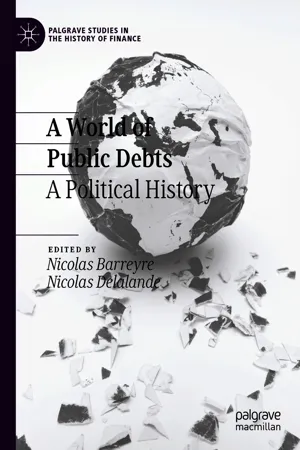By the end of the eighteenth century, public debt became a major issue in many countries throughout Europe. The need to fund repeated wars, each more global in its reach than the previous one—what some historians called the “second hundred years war”—the mounting debt levels, but also the transformations of public discourse on what public debt actually was, all brought about a reconceptualization that is still influential in the ways we understand public debt today.
Yet, that understanding needs revising. Much of the scholarship has erected the conflicting experiences of Britain and France in the late eighteenth century as a lesson about good practices and good institutions, consecrating the British peculiar setup as a model of “successful” public debt. As this first part will show, however, there were a variety of viable ways of borrowing and managing debts for European states, and what really turned them into an issue had more to do with the political legitimacy of political institutions, and to whom they catered, than any measure of economic sustainability. The historical cases of Spanish America, France, and Sweden explored here thus suggest that we should revisit this period, and revise even well-known examples such as Britain, to better understand the reasons why, by the mid-nineteenth century, a liberal debt regime became dominant in Europe before being exported, sometimes forcefully, to other parts of the world. As we argue, those reasons were largely political.
As Regina Grafe underlines in Chap. 1, public financial institutions (including public debt) were themselves the result of political compromise, settlement, and pragmatism. Spanish American colonies had developed a very different system from the one the British were then consolidating. This decentralized, interconnected network of local Treasury chests, enmeshing religious institutions and merchant capital into its circuits, enabled the Spanish to sustain what was then the largest empire in the world while keeping the central government with little debt compared to other European powers. Yet this system rested on the political legitimacy of Church and Crown—precisely what the revolutionary wars in Europe, then the wars of independence in Spanish America, destroyed. The lessons liberal reformers tried to apply were, precisely, the wrong ones.
This question of political legitimacy and liberal reform going awry is where Rebecca Spang picks up in Chap. 2. As she argues, it was the political fight around public finance, rather than economic unsustainability, that made the French Monarchy’s debt problematic in the 1780s and precipitated the French Revolution. In turn, the revolutionaries tied public debt (and honoring it) to the very legitimacy of the new regime and the financial instruments it wielded. The political centrality of public debt, thus, was a crucial engine in the radicalization of the Revolution; and, in turn, the partial default of 1797, while sealing the fate of the regime, also gave its successors the tools to rebuild a new political legitimacy.
Public debt and its management had thus become, in the eighteenth century, a key lever for the control of political power and the state. Sweden’s example, Patrik Winton argues in Chap. 3, might be little known but is illuminating in that regard. Describing several key episodes from the mid-eighteenth century to the 1820s, he shows how public debt was intimately tied to the nature of the political regime, and who wielded power within the state structure. Decisions to borrow domestically or abroad, and between various lenders in Europe, all had an impact on the internal balance of power in Sweden, and the institutional makeup of a regime, that balanced between the absolutist power of the king and more divided power between the estates—until French Marshal Bernadotte turned king of Sweden could attach the new public debt of the country to his own person, thus definitely building his own political legitimacy.
The importance of public debt in building political legitimacy in post-revolutionary Europe is at the heart of David Todd and Alexia Yates’s argument in Chap. 4. Returning to France, they show how the state, in spite of multiple changes of regimes, could rebuild a political legitimacy through debt in the post-Napoleonic years. It did it through intellectual and material innovations that produced a positive view of public debt as citizen democratic participation in the life of the state—and its foreign relations. That France could become so rapidly a financial powerhouse after the Revolution and the indemnities imposed on it in 1815 is a testament to this new system, that was compatible with the ascendant liberal debt regime that dominated the world in the second half of the nineteenth century, but represented a significant variation with long-term consequences—all the way to World War I.
